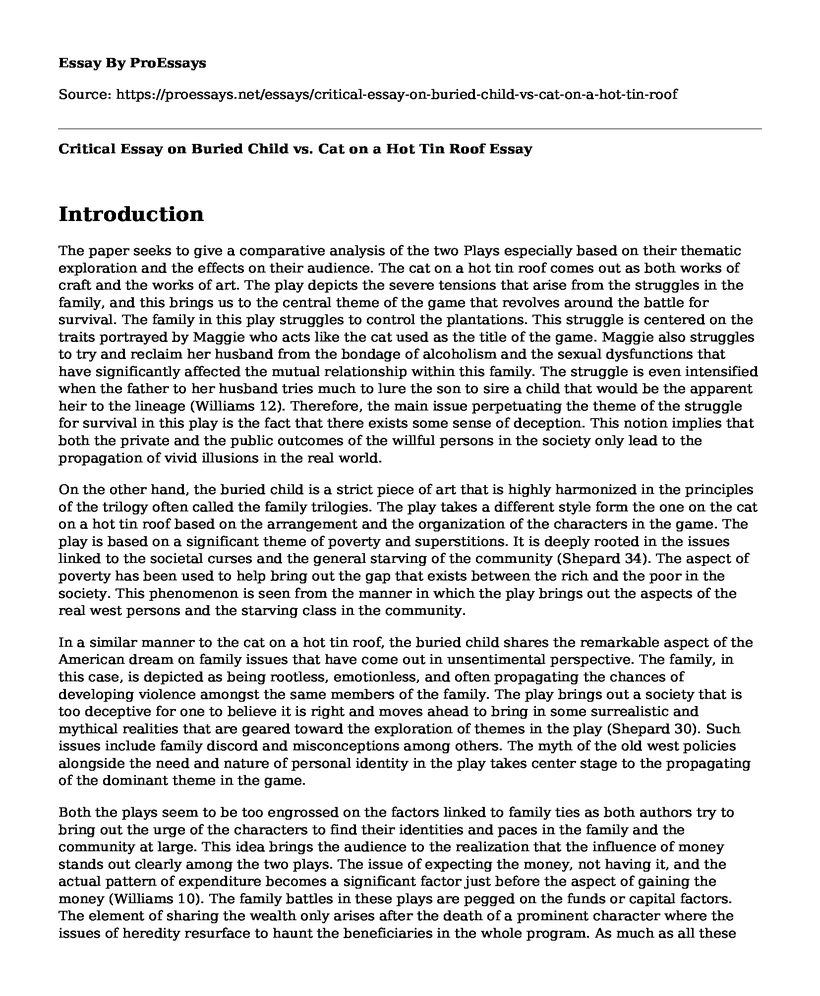Introduction
The paper seeks to give a comparative analysis of the two Plays especially based on their thematic exploration and the effects on their audience. The cat on a hot tin roof comes out as both works of craft and the works of art. The play depicts the severe tensions that arise from the struggles in the family, and this brings us to the central theme of the game that revolves around the battle for survival. The family in this play struggles to control the plantations. This struggle is centered on the traits portrayed by Maggie who acts like the cat used as the title of the game. Maggie also struggles to try and reclaim her husband from the bondage of alcoholism and the sexual dysfunctions that have significantly affected the mutual relationship within this family. The struggle is even intensified when the father to her husband tries much to lure the son to sire a child that would be the apparent heir to the lineage (Williams 12). Therefore, the main issue perpetuating the theme of the struggle for survival in this play is the fact that there exists some sense of deception. This notion implies that both the private and the public outcomes of the willful persons in the society only lead to the propagation of vivid illusions in the real world.
On the other hand, the buried child is a strict piece of art that is highly harmonized in the principles of the trilogy often called the family trilogies. The play takes a different style form the one on the cat on a hot tin roof based on the arrangement and the organization of the characters in the game. The play is based on a significant theme of poverty and superstitions. It is deeply rooted in the issues linked to the societal curses and the general starving of the community (Shepard 34). The aspect of poverty has been used to help bring out the gap that exists between the rich and the poor in the society. This phenomenon is seen from the manner in which the play brings out the aspects of the real west persons and the starving class in the community.
In a similar manner to the cat on a hot tin roof, the buried child shares the remarkable aspect of the American dream on family issues that have come out in unsentimental perspective. The family, in this case, is depicted as being rootless, emotionless, and often propagating the chances of developing violence amongst the same members of the family. The play brings out a society that is too deceptive for one to believe it is right and moves ahead to bring in some surrealistic and mythical realities that are geared toward the exploration of themes in the play (Shepard 30). Such issues include family discord and misconceptions among others. The myth of the old west policies alongside the need and nature of personal identity in the play takes center stage to the propagating of the dominant theme in the game.
Both the plays seem to be too engrossed on the factors linked to family ties as both authors try to bring out the urge of the characters to find their identities and paces in the family and the community at large. This idea brings the audience to the realization that the influence of money stands out clearly among the two plays. The issue of expecting the money, not having it, and the actual pattern of expenditure becomes a significant factor just before the aspect of gaining the money (Williams 10). The family battles in these plays are pegged on the funds or capital factors. The element of sharing the wealth only arises after the death of a prominent character where the issues of heredity resurface to haunt the beneficiaries in the whole program. As much as all these issues are linked to money, the most significant question revolves around the reality of these claims because every person in the society must have some personal stories concerning money and family. Amazingly, in the cat in the hot tin roof, there is only one character that seems not to be swayed into the whole confusion of money issues, and this is Brick. He felt he had had enough of life and did not care about whatever could happen in the future as nature had already taken its course throughout his lifetime.
On a closer look at his life, we see the desperation and stress that must have driven him toward alcoholism. His sexuality explains how he suffered in between different personalities in his life. The aesthetic wife that he never loved, a caring father, and the hidden love for another man were the three significant issues that could be levied for his act of being a drunkard. The theme of male chauvinism takes place in these plays as we see most of the women struggling life and often helpless without the help of their husbands (Williams 15). Margaret came out of nothing and could quickly go back to nothing if she dares divorce Brick.
Works Cited
Shepard, Sam. Buried Child. Dramatists Play Service Inc., 1997.
Williams, Tennessee. Cat on a hot tin roof. Bloomsbury Publishing, 2014.
Cite this page
Critical Essay on Buried Child vs. Cat on a Hot Tin Roof. (2022, Jun 23). Retrieved from https://proessays.net/essays/critical-essay-on-buried-child-vs-cat-on-a-hot-tin-roof
If you are the original author of this essay and no longer wish to have it published on the ProEssays website, please click below to request its removal:
- Essay Sample on Summer Concerto by Vivaldi
- Literary Analysis Essay on Heart of Darkness
- Language: A Powerful Tool to Express & Relate - Essay Sample
- Essay Sample on Symbolism White Teeth by Zadie Smith
- Essay Example on Romanticism: The Power of Human Emotions & Nature
- Essay Sample on Warner Music: Challenges of Thriving After Elimination of Tours
- The Artist 2011 - Movie Analysis Essay







